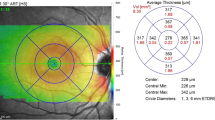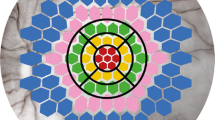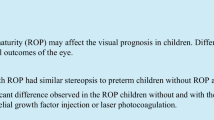Abstract
Color vision was examined by psychophysical tests and photopic color full-field electroretinography (ERG) in formerly preterm children, and compared with those of full-term children. In a prospective case–control study, 25 patients with a history of preterm birth 7–14 years of age were divided into three groups: group I, laser-treated retinopathy of prematurity [ROP] (n = 7); group II, spontaneously regressed ROP (n = 8); group III, no ROP (n = 10). Age-matched full-term born children comprised the control group (n = 8). Color vision was assessed by Fansworth D15 and Lanthony desaturated D15 tests. The cone function was tested using photopic full-field ERG. Besides the ISCEV standard stimuli, blue light on amber background was also used (S-cone ERG). The correlation between ERG parameters and prematurity or ROP was determined. We found no significant differences between any patient group and the control group in the results of the psychophysical tests, and implicit times of the ERG responses. The ERG b-wave amplitudes were significantly lower in group I (laser-treated ROP) compared to controls, for 2 of 4 stimulus conditions i.e. the standard (P = 0.028) and S-cone (P = 0.017) single flash ERGs. The general estimating equation model statistics found a significant effect of prematurity on the b-wave amplitudes (P = 0.025, standard, P = 0.014, S-cone ERG). A slightly reduced photopic ERG b-wave amplitude may be associated with prematurity.


Similar content being viewed by others
References
Gallo JE, Lennerstrand G (1991) A population based study of ocular abnormalities in premature children aged 5 to 10 years. Am J Ophthalmol 111:539–547
Keith CG, Kitchen WH (1983) Ocular morbidity in infants of very low birth weight. Br J Ophthalmol 67:302–305
Dowdeswell HJ, Slater AM, Broomhall J, Tripp J (1995) Visual deficits in children born at less than 32 weeks’ gestation with and without major ocular pathology and cerebral damage. Br J Ophthalmol 79:447–452
Snir M, Nissenkorn I, Sherf I, Cohen S, Sira IB (1988) Visual acuity, strabismus and amblyopia in preterm babies with and without retinopathy of prematurity. Ann Ophthalmol 20:256–258
Hungerford J, Stewart A, Hope P (1986) Ocular sequel of preterm birth and their relation to ultrasound evidence of cerebral damage. Br J Ophthalmol 70:463–468
Abramov I, Hainline L, Lennerise E, Brown A (1985) Changes in visual functions of children exposed as infants to prolonged illumination. J Am Optometric Assoc 56:614–619
O’Connor AR, Stephenson T, Johnson A, Tobin MJ, Moseley MJ, Ratib S, Ng Y, Fielder AR (2002) Long-term ophthalmic outcome of low birth weight children with and without retinopathy of prematurity. Pediatrics 109:12–18
O’Connor AR, Stephenson T, Johnson A, Tobin MJ, Moseley MJ, Ratib S, Fielder AR (2004) Visual outcome in low birth weight children. Br J Ophthalmol 88:1149–1153
Mcloone E, O’Keefe M, Mcloone S, Lanigan B (2006) Long term functional and structural outcomes of laser therapy for retinopathy of prematurity. Br J Ophthalmol 90:754–759
Dobson V, Quinn GE, Abramov I, Hardy RJ, Tung B, Siatkowski RM, Phelps DL (1996) Color vision measured with pseudoisochromatic plates at five and-a-half years in eyes of children from the CRYO-ROP study. Invest Ophth Vis Sci 37:2467–2474
Reisner DS, Hansen RM, Findl O, Petersen RA, Fulton AB (1997) Dark-adapted thresholds in children with histories of mild retinopathy of prematurity. Invest Ophth Vis Sci 38:1175–1183
Hansen RM, Fulton AB (2000) Background adaptation in children with a history of mild retinopathy of prematurity. Invest Ophth Vis Sci 46:3458–3462
Fulton AB, Hansen RM, Petersen RA, Vanderveen DK (2001) The rod photoreceptors in retinopathy of prematurity: an electroretinographic study. Arch Ophthalmol 119:499–505
Moskowitz A, Hansen RM, Fulton AB (2005) Early ametropia and ROD photoreceptor function in retinopathy of prematurity. Optom Vis Sci 82:307–317
Fulton AB, Hansen RM, Moskowitz A (2008) The cone electroretinogram in retinopathy of prematurity. Invest Opht Vis Sci 49:814–819
An International Committee for Classification of retinopathy of prematurity (2005) The International Classification of retinopathy of prematurity. Arch Ophthalmol 123:991–999
Good GW, Schepler A, Nichols JJ (2005) The reliability of the Lanthony Desaturated D-15 test. Optom Vis Sci 82:1054–1059
Marmor MF, Fulton AB, Holder GE, Miyake Y, Brigell M, Bach M (2009) Standard for clinical electroretinography (2008 update). Doc Ophthalmol 118:69–77
Hammer XD, Iftimia NV, Ferguson RD, Bigelow CE, Ustun TE, Barnaby AM, Fulton AB (2008) Foveal fine structure in retinopathy of prematurity:An Adaptive Optics Fourier Domain Optical Coherence Tomography study. Invest Ophht Vis Sci 49:2061–2070
Curcio CA, Sloan KR, Kalina RE, Hendrickson AE (1990) Human photoreceptor topography. J Comp Neurol 292:497–523
Curcio CA, Kimberly AA, Sloan KR, Lerea CL, Hurley JB, Klkock IB, Milam AH (1991) Distribution and morphology of human cone photoreceptors stained with anti-blue-opsin. J Comp Neurol 312:610–624
Wellard J, Lee D, Valter K, Stone J (2005) Photoreceptors in the rat retina are specifically vulnerable to both hypoxia and hyperoxia. Vis Neurosci 22:501–507
Perkins GA, Ellisman MH, Fox DA (2003) Three-dimensional analysis of mouse rod and cone mitochondrial cristae architecture: bioenergetic and functional implications. Mol Vis 9:60–73
Nihira M, Anderson K, Gorin FA, Burns MS (1995) Primate rod and cone photoreceptors may differ in glucose accessibility. Invest Opht Vis Sci 36:1259–1270
Ecsedy M, Szamosi A, Karko C, Zubovics L, Varsanyi B, Nemeth J, Recsan Zs (2007) Comparison of Macular Structure Imaged by Optical Coherence Tomography in Preterm and Full-Term Children. Invest Opht Vis Sci 48:5207–5211
Fulton AB, Hansen RM, Moskowitz A, Barnaby AM (2005) Multifocal ERG in subjects with a history of retinopathy of prematurity. Doc Ophthalmol 111:7–13
Padmos P, Norren D, Jaspers Faijer JW (1978) Blue cone function in a family with an inherited tritan defect tested with electroretinography and psychophysics. Invest Ophthalmol Vis Sci 17:436–441
Sawusch M, Pokorny J, Smith VC (1987) Clinical electroretinography for short wavelength sensitive cones. Invest Ophthalmol Vis Sci 28:966–974
Miyake Y, Yagasaki K, Ichikawa H (1985) Differential diagnosis of congenital tritanopia and dominantly inherited juvenile optic atrophy. Arch Ophthalmol 103:1496–1501
Gouras P, MacKay CJ (1990) Electroretinographic responses of the short-wavelength-sensitive cones. Invest Ophthalmol Vis Sci 31:1203–1209
Xiao M, Hendrickson A (2000) Spatial and temporal expression of short long/medium, or both opsins in human fetal cones. J Comp Neurol 425:545–559
Bumsted-O’Brien KM, Shulte D, Hendrickson AE (2003) Expression of photoreceptors-associated molecules during fetal eye development. Mol.Vis 9:401–409
Giusti C (2001) Lanthony 15-Hue Desturated Test for screening of early color vision defects in uncomplicated juvenile diabetes. Jpn J Ophthalmol 45:607–611
Verriest G, Lethem JV, Uvijls A (1982) A new assessment of the normal ranges of the Farnsworth-Munsell 100-Hue test scores. Am J Ophthalmol 93:635–642
Conflict of interest
None.
Author information
Authors and Affiliations
Corresponding author
Rights and permissions
About this article
Cite this article
Ecsedy, M., Varsányi, B., Szigeti, A. et al. Cone function in children with a history of preterm birth. Doc Ophthalmol 122, 141–148 (2011). https://doi.org/10.1007/s10633-011-9268-z
Received:
Accepted:
Published:
Issue Date:
DOI: https://doi.org/10.1007/s10633-011-9268-z




